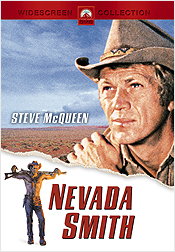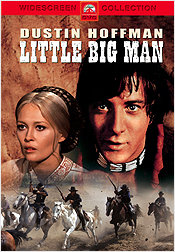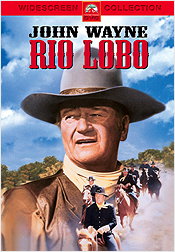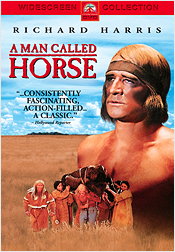 |
Site created 12/15/97.

page created: 6/2/03
 Back to Part One Barrie Maxwell - Main Page |
| More
Reviews Nevada Smith One of my guilty pleasures of the 1960s is comprised of several films of George Peppard's - he of the sleepy-eyed, wooden school of acting. Solid production values, fine supporting casts, and entertaining if pot-boiler-like plots all made the likes of The Blue Max, Operation Crossbow, and The Carpetbaggers reasonable time-passers. The latter, the least of the three, is of relevance here because one of its pluses was the character of Nevada Smith played by the often under-appreciated Alan Ladd. The story goes that Ladd's work was good enough to inspire the idea of a prequel that would focus on the Nevada Smith character with Ladd starring as him. Unfortunately, Ladd died of an apparent accidental medication overdose and the part eventually went to Steve McQueen. The film's plot is a story of revenge. Max Sand is a young man, half-white half-Indian, whose parents are brutally murdered by three thugs when Max's father refuses to reveal the hiding place of some gold that the three believe he has hidden away. Though unschooled in many of the ways of the West's hard life, Max sets out to track down and kill the three murderers. In the process, he is first assisted by a traveling gunsmith named Jonas Cord. Max later assumes the name of "Nevada Smith" and his quest takes him from the West to the swamps of Louisiana and back again. |
| Of
the eight Paramount westerns under discussion, Nevada
Smith presented the most problems for developing an
acceptable DVD presentation. The available source materials were in
rough shape and significant work was required to wrest as good a
transfer from them as Paramount has managed. The 2.35:1 anamorphic
results are quite good if not as impressive as the others in the
batch. Colours appear accurate though a little subdued. Some grain
intrudes from time to time. The results overall represent a
substantial upgrade from the existing video versions and fans should
not be disappointed. The audio is clear and Alfred Newman's score
sounds quite dynamic for a mono track. There are no extras.
Recommended. Little Big Man This is the tale of Jack Crabb - card sharp, gunfighter, medicine salesman, drunk, Indian brave, cavalry scout - who manages to survive the battle of the Little Big Horn and live to the ripe old age of 121. I first remember seeing this film at a special preview and being modestly entertained by something that was distinctly different from the traditional western. Of course, Dustin Hoffman is no one's idea of a western protagonist, but he seemed to fit the various facets of the title character of Jack Crabb quite well. This was perhaps the first western to offer essentially no ties to westerns of the past. You can scan your way down the lengthy cast list, but you'll find virtually no one with western credits to their name. Certainly the stars (Hoffman and Faye Dunaway) were in virgin territory and even the co-stars like Martin Balsam and Richard Mulligan (other than a credit in 1969's The Undefeated) were new to westerns. Chief Dan George was also, but one could at least say he knew what he was doing in one. Director Arthur Penn had directed The Left Handed Gun in 1958, but he was much better known for films with contemporary settings. |
| If
despite that, Little Big Man
is your cup of tea, Paramount at least makes it easy to take with
another fine 2.35:1 anamorphic release. The quality of the actual
transfer must be attributed to the film's current rights holder,
CBS, however. CBS commissioned a collaborative effort from RGB
Optical Laboratory (part of IVC) which handled the film restoration,
Chace Productions which looked after audio restoration and the
creation of the Dolby Digital 5.1 track, and IVC itself which
handled the High Definition transfer and additional digital video
restoration and cleanup. The results are very good considering that
the source material used (the original cut negative) had become torn
and seriously damaged over the years. Colours are generally quite
vibrant and shadow detail is very fine. Edge haloes are almost
non-existent. The digital clean-up has ensured an almost debris-free
presentation. The Dolby 5.1 remix works quite well although it's
little more than a good stereo effect. Surrounds are given but a
modest and infrequent work-out. Still, it's the best the film has
ever sounded on home video. There are no extras. Rio Lobo Rio Lobo represented director Howard Hawks' third drink at the well of a plot that had previously been effectively told with minor variations in both Rio Bravo and El Dorado. In this, the weakest of the three versions, the story starts off with a real bang in the form of a train robbery of some style and freshness. A group of Confederate soldiers steals a shipment of gold destined for a Union depot where Colonel Cord McNally awaits its arrival. McNally goes in pursuit, but fails to retrieve the gold although he does manage to capture two of the Confederates - Captain Pierre Cordona and Sergeant Tuscarora Phillips. The Civil War ends soon thereafter and McNally befriends Cordona and Phillips because he still wants to track down the men responsible for betraying the details of the gold shipment to the Confederacy and thus guilty of treasonable activity. The trail eventually leads to the Rio Lobo country of Texas where a town is being held under the thumb of local rancher Ketcham and his corrupt sheriff Hendricks. |
| The
1.85:1 anamorphic image is another sharp-looking effort from CBS via
Paramount Home Video. This time the original negative was in pretty
good shape (compared to that of Little
Big Man, for example), so the restoration process was not
nearly so complex. Colours appear accurate although somewhat
subdued, perhaps purposely so given the dusty settings of much of
the film. Edge effects are minor at most. The Dolby 5.1 remix is
quite pleasing although there is little striking directionality or
use of the surrounds. The disc has no extras, somewhat of a
disappointment given that there was an interesting George Plimpton
television special made about his appearance in a bit part in the
film. That would have made for a fine disc supplement. Big Jake After Rio Lobo, Big Jake was a distinct improvement in terms of a unified story line and a plot that veteran director George Sherman drives along briskly. (This would be Sherman's last film, capping a career in westerns extending over five decades. He had previously worked with John Wayne in the Three Mesquiteer westerns that Wayne starred in for Republic in the late 1930s.) The story revolves around the kidnapping of young Jacob McCandles from the ranch of his grandmother Martha who has been estranged from her husband Jacob (Big Jake of the title) McCandles for many years. The kidnapping is carried out by a gang of nine men headed by John Fain, who demands a ransom of $1 million for the young boy's return. Martha calls on Big Jake, despite their past differences, as the only man who can save their grandson. With the money in tow on the back of a donkey and gradually gathering help from his two sons and an old Indian compatriot, Big Jake heads to Mexico to pay the ransom. |
| Filming
was based in Durango, Mexico with plenty of advantage being taken of
the surrounding Sonora Desert locations. Later Wayne films such as
The Train Robbers and Cahill
would be filmed there too. I mentioned earlier in the column that
this was a traditional sort of western, and for the most part it is.
One deviation from this is the introduction of early motorized
vehicles (the story is set circa 1910) and even an early automatic
pistol both of which drive a couple of the early sequences. This
foolishness is soon dispensed with after a posse using the vehicles
to track Fain's gang is ambushed and a number of the posse killed.
Thereafter, horse and six-gun rule, as they should in any good
western. CBS's 2.35:1 anamorphic transfer, on DVD courtesy of Paramount, is another fine-looking effort. Colours are vibrant and generally accurate. Edge effects are minor. The Dolby 5.1 track is fine, but as with most such remixes really demonstrates little beyond some front stage separation. There are no extras. Recommended. A Man Called Horse It's hard to know how to take this western. Is it really as realistic of Indian life and rituals as it would have you believe, or is it just the usual Hollywood stretching of the truth to suit dramatic license? Whatever the case, the film is a violent one with definite masochistic tendencies that eventually lead more to tedium than fascination. The story concerns English lord, John Morgan, who while hunting in the West, is captured by a band of Sioux Indians. He is taken to their village and forced to suffer degrading treatment, but gradually he wins their respect and resolves to undergo the Vow of the Sun initiation, in order to gain complete acceptance. Afterwards, he settles into the life of the village, but that is all threatened when the village is attacked by a rival tribe. |
| The
film inspired two sequels - Return of a
Man Called Horse (1976) and Trials
of a Man Called Horse (1982) - with diminishing returns. There's not much new to say about these CBS restorations issued by Paramount. The 2.35:1 anamorphic transfer is another good one although not quite as consistently crisp as the other three. Edge effects are once again negligible. The Dolby 5.1 sound remix is unremarkable. There are no extras. New Classic Announcements Well, we've got the usual grab-bag of items this time with just about all the various distributors chiming in with announcements. There's also some new Region 2 plans of interest. As usual, the Classic Release Database on the website has been updated to reflect all the new information. Let's start off with Image this time. July 8th brings Charlie Chaplin: Short Comedy Classics - a seven-disc box set that repackages the previously released six discs of Essanay and Mutual shorts along with a new disc containing a 1996 documentary Chaplin's Goliath: In Search of Scotland's Forgotten Star which focuses on Eric Campbell, the heavy in many of the Mutual shorts. On the same date, expect Tempest, a 1928 film with John Barrymore. The middle of the month brings a film from Alice Faye's early Fox period, 365 Nights in Hollywood (1934), a double bill of Salome (1921, with Nazimova) and Lot in Sodom (1933), and Slapstick Masters which combines a short from each of Chaplin, Keaton, Monte Banks, and Laurel and Hardy on one disc. The pace picks up even more so on July 29th with the release of the French film Chess Player (1927), two Gene Autry films mentioned in a previous Classic Coming Attractions column (Bells of Capistrano and Sioux City Sue), a 1948 exploitation double feature of Street Corner and Because of Eve, Woody Allen in What's Up Tiger Lily (1966), and two Republic serials that seem to be available from everybody - Radar Men from the Moon (1952) and Zorro's Fighting Legion (1939). It is expected that Image will also be releasing the forthcoming Cecil B. DeMille titles, although no dates have been announced as yet. The films are being prepared for DVD by David Shepard. First up will be a double bill of Why Change Your Wife (1920) and Miss Lulu Bett (1921, directed by William DeMille). Following will be Don't Change Your Husband (1919), Old Wives for New (1918), and The Golden Chance (1915). Kino has interesting news as well. July 22nd will bring the release of Rene Clair's It Happened Tomorrow (1944), Douglas Sirk's Scandal in Paris (1945), They Made Me a Fugitive (1947, with Trevor Howard), and a double bill of St. Martin's Lane (1938, with Charles Laughton) and Wings of the Morning (1937, with Henry Fonda). On August 12th, expect Assunta Spina (1947, with Anna Magnani) and Holy Mountain [aka Der Heilige Berg] (1926, with Leni Riefenstahl). The previously-announced German sound films Adventures of Baron Munchausen, La Habanera, and Titanic are now set for September 2nd. Most exciting is the announcement of The Man Who Laughs (1928, with Conrad Veidt), Applause (1929, with Helen Morgan), and Love Me Tonight (1932, with Maurice Chevalier) coming to DVD with The Man Who Laughs first, late this year. All are presumably coming as a result of Kino's occasional working relationship with Universal. Warner Brothers will release Monte Walsh (1970, with Lee Marvin) on July 29th, but more significantly has announced August 5th as the release date for the two-disc 60th anniversary release of Casablanca. Included will be 10 minutes of recently discovered deleted scenes and outtakes, two audio commentaries from critic Roger Ebert and historian Rudy Behlmer, a featurette The Children Remember, which includes memories from son Stephen Bogart and Bergman daughters Pia Lindstrom and Isabella Rossellini, two documentaries hosted by actress Lauren Bacall (You Must Remember This: The Making of Casablanca and Bacall on Bogart), a Screen Guild Players Radio Production with the film's stars, scoring session outtakes, and an introduction by Bacall. Part of Warner Brothers' classic plans in 2004 are 20 classic titles that the company has already mastered and archived supplementary materials for. The titles are: The Actress, After the Thin Man, Another Thin Man, The Asphalt Jungle, Bad Day at Black Rock, The Blackboard Jungle, Days of Wine and Roses, Dr. Jekyll and Mr. Hyde, Executive Suite, Finian's Rainbow, For Me and My Gal, The Good Earth, I'll Cry Tomorrow, Love Finds Andy Hardy, Night of the Iguana, The Postman Always Rings Twice, Somebody Up There Likes Me, Where the Boys Are, The Wind and the Lion, and Ziegfeld Girl. The company will allow AOL members to vote, between June 2nd and July 1st, for the five titles on this list that will appear first, next January. In other Warner news, the company is apparently working on restorations of the classic Popeye cartoons they control (the classic Paramount [Fleischer/Famous] ones). There is no arrangement for any DVD release at this time since King Features has a say in that, but the deteriorating condition of the source material has prompted WB's action anyway, to its credit. August 5th's Fox Studio Classics release of The Inn of the Sixth Happiness will include a remastered 2.35:1 anamorphic widescreen transfer, English 2.0 stereo and French and Spanish mono dubs, two Sean Connery screen tests, two Movie Tone News reels (Inn of the Sixth Happiness - Rapturous and Hollywood Premiere), a still gallery, and two theatrical trailers. Fox has delayed the previously announced Star! (1968, with Julie Andrews) indefinitely, to enable additional supplements to be included. The August 19th release of Hello Dolly! (1969, with Barbra Streisand) will include an anamorphic transfer with a new retrospective and some original featurettes. Paramount will have Peter Bogdanovich's Targets (1968) in August. Hud (1963, with Paul Newman and Patricia Neal) is also on its way although no date has been set as yet. The Preston Sturges website now lists Paramount's Miracle at Morgan's Creek as coming soon, rather than this summer as previously suggested. Disney will accelerate the schedule of its two-disc Platinum Collection releases of such classic animated features as 101 Dalmatians, Aladdin, Bambi, Cinderella, The Little Mermaid, Lady and the Tramp, and Pinocchio. Starting in 2004, it will release two of these titles per year, one in March and the other in October. The Vault Disney Collection of two-disc editions will continue, but they will not be labeled as such. The most recent example is this month's release of 20,000 Leagues under the Sea (1954). The third wave of Disney Treasures is scheduled for a December 2nd release. 2004 will bring SEs of Alice in Wonderland on January 24th and Mary Poppins on August 17th. Universal has set McHale's Navy (1964) for a June 3rd release. There will be an anamorphic transfer and the theatrical trailer. On July 1st, we'll get a couple of Rock Hudson films - Man's Favorite Sport? (1964, directed by Howard Hawks) and Strange Bedfellows (1965). Then on September 2nd, Don Knotts fans can celebrate with The Ghost and Mr. Chicken (1966), The Reluctant Astronaut (1967), The Shakiest Gun in the West (1968), The Love God? (1969), and How to Frame a Figg (1971). The latter two will be full frame while the others will be anamorphic. Columbia's only new classic announcement is Rocky & Bullwinkle & Friends: The Complete First Season, which will appear August 12th and include full-frame screen episodes and mono tracks, a 16-page booklet, a never before seen Bullwinkle puppet segment, vintage Rocky & Bullwinkle TV spots, and a "Sneak Peek at Season 2". Criterion will present Vittorio De Sica's Umberto D. (1952) on August 22nd. The film has been restored in its original 1.37:1 aspect ratio and Italian mono. Supplements will include an Italian television documentary about De Sica, a new interview with Ileana Simova (one of the actors in the film), plus the trailer. It is anticipated that De Sica's Terminal Station in both its original European cut and the truncated American release version (retitled Indiscretion of an American Wife [1953]) will appear later this year as a 2-disc set. On July 22nd, Artisan will give us Blood on the Sun (1945, with James Cagney - the big question being, will Artisan's release be any better than the collection of public domain versions already available?), A Double Life (1947, with Ronald Colman's Oscar-winning performance), Four Faces West (1948, with Joel McCrea), and The Red Pony (1949, with Robert Mitchum), as well as The Best of Bonanza #1 (the television series). All are likely to be bare-bones releases. Anchor Bay reports a July 8th release for two British comedies, Till Death Do Us Part (1968) and Who Done It? (1956, with Benny Hill). Both have been remastered in 1.66:1 anamorphic widescreen and contain their original mono tracks and trailers. The latter will also contain The Waiters, a 30-minute Benny Hill short film, plus a Benny Hill biography. The company also indicates that The Colditz Story, The Cruel Sea, The Dam Busters, and Went the Day Well are still very much in their plans, but there is no information on timing at present. Hart Sharp Video and Sinatra Enterprises will team up for a special edition DVD release of The Man with the Golden Arm (1955, starring Sinatra and directed by Otto Preminger) later this year. In Region 2 news, Universal will release a two-disc SE of Citizen Kane (1941) on June 23rd. It's not clear if this will be the same transfer as WB's Region 1 release, but the supplements will be different. They include a new custom-made 50 minute documentary presented by Barry Norman, Welles' original 1938 radio broadcast of The War of the Worlds, a behind the scenes stills gallery, cast and crew profiles, Welles' 1945 commercial recording of Oscar Wilde's The Happy Prince with Bing Crosby and supporting cast and music by Bernard Herrmann, an audio commentary by film historian Ken Barnes, the original film budget, and a collectible booklet featuring an essay on Welles and Kane. Also coming on June 23rd are three double bills from Warner. They are: The Blue Lamp (1950, with Dirk Bogarde) paired with The Nanny (1965, with Bette Davis), The Accident (1967, with Dirk Bogarde) paired with The L-Shaped Room (1962, with Leslie Caron), and Darling (1965, with Julie Christie) paired with The Family Way (1966, with Hayley Mills). All will be mono and framed at 1.66:1, except The Blue Lamp at 1.37:1. Eureka will issue a two-disc SE of Fritz Lang's M (1931) on September 23rd. Included will be a new digital transfer from the restoration negative, an audio commentary, a 1964 interview with Lang, a 50-minute documentary The Hunt for M, and more. Finally, RKO classic enthusiasts should take note that some of RKO's desirable titles are already available through Editions Montparnasse. Although these are French releases, the original English tracks are usually included with defeatable French subtitling. Check out the website editionsmontparnasse.com. That's it for now. See you all again soon. Barrie Maxwell barriemaxwell@thedigitalbits.com |
Barrie Maxwell - Main Page
 |
| Site
designed for 1024 x 768 resolution, using 16M colors and .gif 89a
animation. © 1997-2015 The Digital Bits, Inc., All Rights Reserved. billhunt@thedigitalbits.com |




